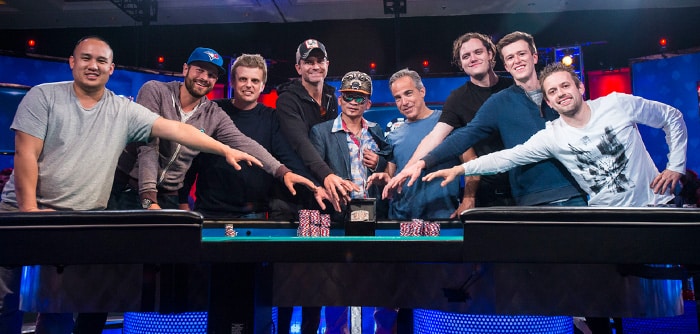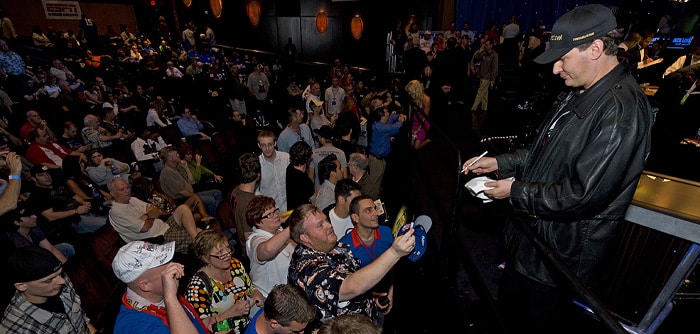WSOP Bracelets
What is a WSOP Bracelet Worth?
While a World Series of Poker (WSOP) bracelet is literally worth its weight in gold, the real value is in what it represents – poker greatness.
Winning a WSOP bracelet is the dream of almost every poker player, and while millions have tried over the past five decades, only a fortunate few thousand have managed to capture the coveted piece of jewelry.
The bracelet was introduced at the 1976 WSOP – before that winners received either a silver cup (1970), a “corny trophy” (1971-74), or a silver plate (1975) as recognition for their win – and while the design has changed numerous times since then, the concept remains the same. That is, win a bracelet and etch your name in poker history.
Winning a bracelet is the equivalent of winning the World Cup in football, Stanley Cup in hockey or a Super Bowl ring in American Football. It’s the standard of excellence against which all other poker accomplishments are judged.
As the old saying goes, there are two types of poker players, those who have won a bracelet and those who have not.

Final table players at the 2016 WSOP reach for the Main Event bracelet
The Rise of the WSOP Bracelet
In the early days of the game, a WSOP bracelet didn’t carry the same figurative weight that it does today. Doyle Brunson, winner of 10 bracelets, has even said they “didn’t mean anything” back in the day. In fact, he didn’t even bother to pick two of his up. For the old school gamblers, they were mere trinkets, no one realizing that one day they’d become the game’s gold standard.
Had they known, there’s a good chance legendary players like Brunson, David “Chip” Reese, and Stu Ungar may have tried harder by playing more tournaments instead of focusing primarily on high-stakes cash games.
One player who recognized the power of a bracelet from the start was 1989 WSOP Main Event champ Phil Hellmuth, who has won more than anyone else in history.
“To me," Hellmuth said, “the bracelets have always been a really huge deal, to me more than the other guys, because I knew that they represented history."
When poker exploded in the mid-2000s, winning a bracelet became the dream of almost every poker player. When she captured one in the 2005 WSOP Women’s Championship, actress Jennifer Tilly said that winning the bracelet was “better than an Oscar.”

Phil Hellmuth signs autographs for fans at the 2009 World Series of Poker
Bracelets Beyond Las Vegas
For decades, the WSOP was limited to Las Vegas, but that changed in 2007 with the launch of the World Series of Poker Europe (WSOPE) in London. It was there that Thomas Bihl became the first player in WSOP history to win a bracelet outside Las Vegas after he won the £2,500 World Championship H.O.R.S.E. event.
Since then, the WSOP brand has continued to expand, and with it the opportunities to win bracelets such as the WSOP Asia-Pacific (WSOP APAC), WSOP Global Championship, and online at both WSOP.com and GGPoker.
In 2015, the WSOP awarded its first-ever online bracelet event in Event #64: $1,000 WSOP.com Online No-Limit Hold’em, which attracted 905 players and saw Anthony “holdplz” Spinella win it for $197,743.
Over the next five years, online bracelet offerings only increased, especially in the summer of 2020 when they were the only options due to the unprecedented pandemic. In July 2020, WSOP.com awarded 31 bracelets and $26,871,265 in prize money to players competing from New Jersey and Nevada. For international players, they had the chance to compete for one of 54 bracelets on GGPoker.
The series proved to be a tremendous success, awarding bracelets to players like Lev Gottlieb, Daniel Dvoress, Kristin Bicknell, Yuri Dzivielevski, David Peters, Fedor Holz, Connor Drinan, Juha Helppi, and two-time winner Alek Stasiak.
The GGPoker 2020 bracelet events culminated with a $5,000 Main Event, a tournament that was awarded an official Guinness World Record for the largest prize pool for a single online poker tournament. With 5,802 entrants, a $27,559,500 prize pool was up for grabs.
Bulgaria’s Stoyan Madanzhiev ultimately won that tournament for $3,904,686, the biggest first-place prize awarded in the history of online poker.

Variations of the World Series of Poker logo for some of the expansion events
Designers of WSOP Bracelets
When they were first introduced, a WSOP bracelet cost approximately $500 to produce. Starting in the 1980s, Las Vegas based jeweler Mordechai Yerushalmi manufactured bracelets up until Harrah’s Entertainment acquired the WSOP in 2004. Since then, companies that have produced WSOP bracelets include Diamond International, Frederick Goldman, Inc., Corum, OnTilt Designs, Jason of Beverly Hills, and Josten’s.
In recent years, a special one-of-a-kind bracelet is designed for the winner of the Main Event. For instance, the 2012 WSOP Main Event bracelet designed by Jason Arasheben of Jason of Beverly Hills featured the four suits with rubies for hearts and diamonds, and black diamonds for spades and clubs. That bracelet weighed over 160 grams of 14 karat gold and over 35 carats of flawless diamonds.
Fun WSOP Bracelet Facts
In 2010, Peter Eastgate auctioned off his 2008 WSOP Main Event bracelet. The starting bid on eBay was $16,000, but it eventually sold for $147,500, which was donated to the UNICEF charity.
1992 WSOP champ Hamid Dastmalchi wasn’t a fan of his Main Event bracelet, even saying “it’s worth $5,000, but I’d take $1,500 for it.” Ted Forrest replied “sold” and tossed over $1,500 in chips. With that, he bought himself a bracelet (though he’s won six of his own).
Phil Hellmuth, who has won a record 15 WSOP bracelets, has given away 10 of them to various friends and family members.
In 2005, Johnny Chan became the first person to win 10 lifetime bracelets, and he did it just a few days before Doyle Brunson tied him. Along with Phil Ivey and Phil Hellmuth, the “bracelet battle” of the mid-to-late 2000s was on. Ultimately, Hellmuth has pulled ahead to 15 bracelet wins while the others remain tied at 10.
Bill Boyd (1971-74), Doyle Brunson (1976-79), and Loren Klein (2016-19) are the only players to have won bracelets in four consecutive years.
In 1980 and 1981, special “Best All Around Player” bracelets were awarded to “Oklahoma” Johny Hale and Chip Reese respectively. However, these bracelets do not count as official bracelets.
The first-ever “Ladies Event” was the 1977 WSOP Event #9: $100 Ladies Seven-Card Stud, which saw Jackie McDaniel top a 93-entry field to win $5,580 and the bracelet.
Five-Card Stud hasn’t been played at the WSOP since 1974. Prior to that, it was offered four times, and each time the tournament was won by Bill Boyd.
At the 1982 WSOP, officials did not award bracelets. Instead, winners received gold wristwatches. They went back to the bracelets the following year.
A half dozen players have won three bracelets in a single year in Puggy Pearson (1973), Phil Hellmuth (1993), Ted Forrest (1993), Phil Ivey (2002), Jeff Lisandro (2009), and George Danzer (2014).
Chinese Poker bracelet events were offered in both 1995 and 1996 with Gregg Grivas winning one of the tournaments.
Brazil’s Marcelo Jakovljevic was the first player to win a WSOP gold bracelet at GGPoker taking down the 2020 WSOP Online Bracelet Event #32: $100 The Opener for $265,880.


